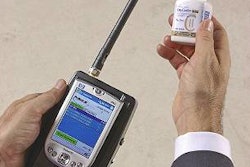Information technology personnel are way ahead of me on knowing about data synchronization. Yet, as a packaging editor covering radio-frequency identification, I discovered recently that I needed to get up to speed on the subject.
My moment of realization came when John Greaves, RFID global firm director at Deloitte Consulting LLC, spoke to Packaging World about RFID in an article published October 2004, which included Wal-Mart’s radio-frequency identification agenda.
“Wal-Mart understands best of all that we cannot simply apply RFID over the current infrastructure,” said Greaves, “otherwise, it would topple like a jelly mold.” It must be built on a foundation of data synchronization, he insisted.
Upon being pressed further about data synchronization, Greaves suggested we talk to an authority on the subject: consultant Paula Giovannetti of EC Workshops. Having been on Uniform Code Council and EAN Intl. committees that determine bar-code standards, she presents an authoritative view of the importance of data synchronization for RFID.
It’s simple, but not easy
Giovannetti began by saying that data synch really isn’t fancy. “It’s that you and I have to get the information straight between us. It’s simple, but it’s not that easy.” Her personal illustration translates to two trading partners, Gillette and Wal-Mart.
“It can often be a sort of sporting event when two trading partners try to synch their data,” Giovannetti said. “That’s it—how are we going to standardize what we’re buying and selling to each other in terms of description, price, cube, weight, and attributes? As companies get more global, standardization becomes more involved, because there are different attributes for different target markets.”
Some companies have one or two full-time personnel doing nothing but solving these kinds of discrepancies and troubleshooting part number, price, and unit of measure, she added.
How does RFID fit into this? For decades, the bar code has allowed a scan as a way to enter a part number. The data “behind” the bar code, of course, needs to be accurate. “The bar code is the point where the [identifying] information touches the physical item,” says Giovannetti. “If you don’t have the correct information in the database, it doesn’t do much good to scan the bar code. Historically, data synch has been done poorly.”
She says that what the bar-code scan does is provide identifying data to a database, of which there are several.
Data attributes
Data synch involves two key attributes: party data and item data. Party data is the entity involved, such as Gillette. Item data refers to identification of the item at the various packaging levels whether that be the primary pack, a carton, or a case. For RFID, the item data is globally and uniquely identified with the Global Trade Item Number, or GTIN, she says.
The goal of retailers like Wal-Mart and Target is a standard public domain with a global registry. The retailer uses the registry catalog to download to its cash registers the item number and corresponding price info.
“In theory, there is an EAN-UCC global registry, not to be confused with UCCnet,” she says. “For a long time, UCCnet was the only way to get into the registry. When someone tells you to be in a global data synch database via the global registry, as of July 1, 2004, UCCNet is now just one of several options.”
The theory is that tapping the data pool yields the item number (GTIN) information. “We don’t have robust implementation of that yet--it looks good on the hanger, but we don’t know how it’s going to wear,” she says.
Ultimately, the tie-in is between the GTIN and RFID marrying the item info with the location info from the RFID environment.
With RFID, the network is going to be in the public domain, that is the Internet, where you can exchange item information with your trading partners. It’s analogous to expanding what you are doing internally within your own warehouse to the outside world.
RFID will provide the ability to access both dynamic event data and static GTIN attribute data; the attribute data is what is in the Global Registry.
Advice for packagers
Giovannetti’s advice to packagers echoes what others have said: “The best way for them to get started is to set up a little lab and start experimenting. Install a printer and purchase ‘smart labels’--those with RFID tags in them. Then start to experiment with where you can read it on the package, where you can’t, and how to read a tagged carton on the inside of the pallet load. Learn how corrugated reacts and how metal reacts and stay as educated as you can on those things that can affect your products and packages. For those using RFID, warehouse management systems (WMS) applications and middleware hold the key. Whatever the rate is that you read the tags, it doesn’t do any good to read it if you don’t do something with it.”
She emphasizes that packagers need to keep scalability in mind. “Unfortunately, what I see happening is that people play with RFID and see that it is fun and that it works, but they don’t really build systems that can scale because it gets big--meaning lots of data to handle--real quick.”
Current, timely, and correct
“The goal is to keep data in one place to be current, timely, and correct,” Giovannetti insists. “In order to do that with RFID, it means automatically accessing the item info at a global registry via the Internet. The best way to do that is for all the trading partners to draw from the same pool containing the latest data. That way, we’re all synchronized--that’s what data synchronization is about.”
For further information and white papers, visit Giovannetti’s Web site, www.ecworkshops.com.























